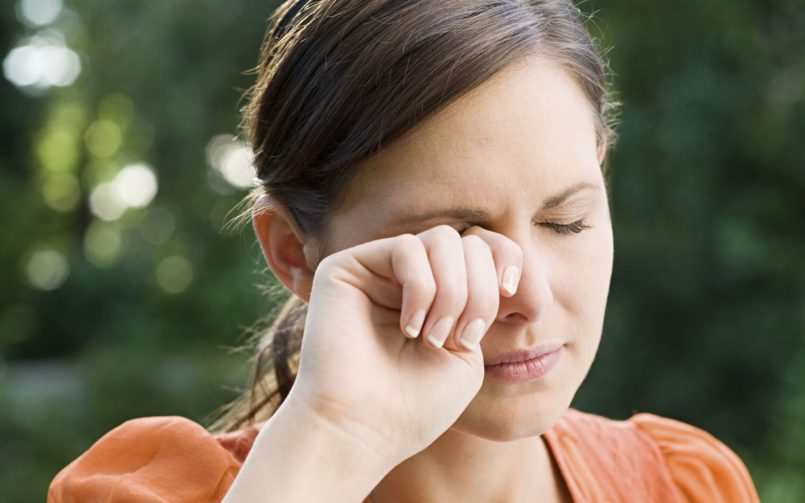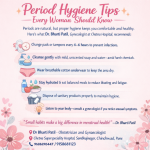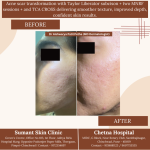About eye injuries – chemical burns
A chemical burn occurs when a liquid (including fresh concrete and hand sanitiser) or powder chemical contacts the eye. Most commonly, the injury happens when a chemical splashes over the face. However, chemical burns may also result from rubbing your eyes after handling chemicals. Depending on the chemical and the degree of exposure, the potential for injury ranges from temporary redness and irritation to blindness and even loss of an eye. On rare occasions, chemicals splashed into the eyes can also cause poisoning as they are absorbed into the bloodstream many times more rapidly than chemicals splashed onto the skin.
Always wear appropriate safety goggles or a face shield when handling liquid or powder chemicals. For splashes of non-toxic liquids, such as soaps or shampoos, flushing the eye with fresh water is usually all the treatment you need. However, splashes from acids or alkali chemicals are serious and may cause vision loss. Rinse the eye and seek urgent medical attention.
Symptoms of chemical burns to the eye
The symptoms of a chemical burn depend on the substance splashed into the eyes, but may include:
- stinging
- a burning sensation
- redness
- pain
- swelling of the eyelids
- blurry vision
- watery eyes.
Complications of chemical burns to the eye
Complications of severe chemical burns can include:
- corneal perforation – full thickness damage to the cornea, the clear surface of the eye
- corneal ulcer – superficial damage to the cornea
- cataracts – an abnormal clouding of the eye’s lens
- glaucoma – high pressure within the eye, which damages the optic nerve.
- retinal damage
- loss of the eye
First aid suggestions for chemical burns to the eye
Liquid or powder splashes from chemicals may seriously damage the eye. In many cases, prompt and thorough rinsing of the eye (with saline or fresh water), dramatically reduces the risk of injury and long-term damage. It’s often better to go straight to the nearest tap than to wait for saline from the first aid kit.
First aid suggestions include:
- Hold your face under running water for 15 to 20 minutes and allow the water stream to flood into your eyes. Use your fingers to hold your eyelids apart (make sure there is no trace of the chemical on your fingers).
- If you wear contact lenses, remove them as soon as possible.
- Seek immediate medical advice. Medical staff will need to know what chemical was involved, particularly whether it was acid or alkaline, liquid or powder.
- Do not judge the seriousness of your eye injury on the degree of pain. For example, alkali chemicals don’t usually cause significant symptoms, but can seriously damage the eye.
- Powder or particulate (granular matter, like wet concrete) chemicals can be particularly damaging since they are more difficult to flush out.
Diagnosis of chemical burns to the eye
Professional care for chemical burns to the eye may include:
- irrigation – the doctor or ophthalmologist will first flush your eyes, even if you’ve already flushed them yourself. In most cases, prompt and thorough rinsing of the eye (with saline or fresh water) dramatically reduces the risk of injury and long-term damage. pH strips can be used to check if the irrigation has removed traces of the chemical
- full eye examination – this is to check for the location of the burn and the amount of damage
- diagnostic tests – may include a fluorescein evaluation, which involves the use of a special dye that colours damaged or dead eye tissue yellow-green when viewed under ultraviolet light
- follow-up examination.
Treatment for chemical burns to the eye
Treatment differs according to the chemical agent and the severity of the injury, but may include:
- pain-relieving medication
- topical antibiotics to reduce the risk of infection
- medicated eye drops
- lubricants applied to the eye surface to prevent the eyelids from sticking to the cornea as it heals
- anti-inflammatory medication
- in more serious cases, hospital admission is necessary and treatment is given for any complications.
Self-care after a chemical burn to the eye
Be guided by your doctor or healthcare professional, but general suggestions include:
- Don’t drive a vehicle while you’re wearing an eye patch.
- Use medication strictly as directed.
- Attend all follow-up appointments.
- See your doctor or eye specialist straight away if you have new symptoms, such as eye pain, redness, photophobia (intolerance of light) or blurry vision.
Always wear eye protection
Estimates suggest that about 90% of chemical burns to the eye are avoidable. Wear eye protection every time you handle liquid or powder chemicals. Prescription glasses or sunglasses do not provide reliable protection, because the loose fit allows liquids or powder to splash behind the frames.
Appropriate safety gear is the best way to reduce your risk of injury. Options depend on the job, but may include:
- safety glasses – look similar to regular prescription glasses, but have shatter-resistant lenses, stronger frames and side shields. However, safety glasses do not seal against the face, which means liquids may splash or run into the eyes. Safety glasses may be an option if the risk of splash is low or if the liquid is non-toxic
- safety goggles – are made from smash-resistant materials and seal against the face. Some styles of safety goggles are large enough to be worn over the top of prescription glasses
- face shields – offer maximum protection against splash injury. In some cases, safety goggles are also worn. Face shields are recommended when handling dangerous chemicals, such as corrosive liquids or powders, cryogenic fluids or biological materials.
#pune #pcmc #chinchwad #hospital #medical #medicalservices #cataract #eyedoctor #eye #glaucoma #conjunctivitis #ophthalmologist #humaneye #eyediseases #eyepain #pinkeye #hazeleyes #presbyopia #eyeinfection #phaco #phacomachine #phacosurgery #eyeproblems #motibindu #motibinduoperation #dryeye #cataractoperation #cataracttreatment #eyesurgeon #motibinduoperation













